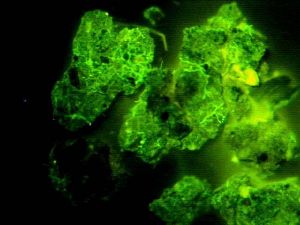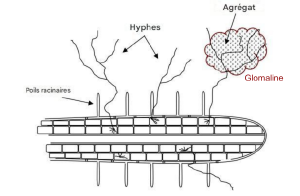Glomalin

It is a hydrophobic, heat-tolerant glycoprotein found on the surface of mycorrhizal spores and mycelia[1]. Glomalin plays an essential role in soil structure and fertility, as well as in carbon sequestration. This molecule was discovered by Sara F. Wright in 1996[2].
Origin

Arbuscular mycorrhizal fungi (AMF) are ancient micro-organisms that evolved with plants to help them acquire nutrients. Most plants (around 70-80% of vascular plants) are mycorrhizal. The hyphae of AMFs extend into the soil and explore a larger volume of soil for nutrient uptake. They produce glomalin, which covers and protects the hyphae[3]. Often referred to as the “soil glue”, it contributes to the formation of stable aggregates, reinforcing soil structure. Glomalin is also known as “glomalin-related soil protein” or GRSP.
Key roles
Aggregate formation and soil health
Glomalin has several properties that make it an excellent protector of soil hyphae and aggregates :
- Resistance : It is extremely resistant to decomposition by soil micro-organisms. Its lifespan in the soil is estimated at between 10 and 50 years. This resistance enables it to protect the hyphae of arbuscular mycorrhizal fungi from microbial attack and maintain the stability of soil aggregates over the long term.
- Insolubility in water : This property is essential for maintaining the integrity of hyphae and soil aggregates in the presence of water, thus preventing their degradation and the loss of nutrients.
- Thermal stability : It is soluble at 121°C, enabling it to be extracted and analyzed in the laboratory, while underlining its resistance to variable environmental conditions.
- Binding capacity : These bonds contribute to the formation of stable, erosion-resistant aggregates.
- Formation of a protective coating : It forms a physical barrier that protects AMF from nutrient loss and mechanical damage.
These combined properties make glomalin a key element in soil health: retaining water, reducing compaction, increasing nutrient availability, limiting water and wind erosion[3].
Carbon sequestration
This slow-decomposing substance accounts for a third of the carbon sequestered in the world's soils.
- Direct carbon storage : The glomalin molecule itself contains between 30 and 40% carbon, meaning that a significant proportion of soil carbon is stored directly in the glomalin structure.
- Protection of stored carbon : The soil aggregates formed by glomalin protect the organic carbon stored in the soil from decomposition by microbes. The stable structure of the aggregates makes the carbon less accessible to micro-organisms, slowing its release into the atmosphere.
- Lifespan : Its long lifespan in the soil enables long-term carbon storage.
- Abundance in the soil : It represents a significant proportion of soil organic matter. Studies have shown that it can constitute up to 27% of total soil carbon, surpassing humic acid, long considered the main contributor to soil carbon[4].
Farming practices that promote glomalin synthesis
- Minimize or eliminate tillage : No-tillage or minimal tillage preserves the integrity of the mycelial network, thus promoting glomalin production.
- Use cover crops to maintain living roots and stimulate CMA.
- Reduce inputs, especially phosphorus[3]. Excessive phosphorus in the soil can inhibit CMA development and reduce glomalin production.
- Encourage mycorrhizal crops : It's important to note that non-mycorrhizal crops (rapeseed, cabbage, broccoli, cauliflower) do not produce glomalin.
Slake test

The slake test is a quick and easy way of assessing the cohesion of soil aggregates[5].
Materials & preparation :
- 2 wide-mouth glass jars.
- 2 pieces of wire mesh 0.6cm by about 4cm x 15 cm.
- 2 clods of soil, each about the size of an egg, the first 5cm of soil from two different areas.
When the soil is undisturbed, more animals, more plants and more micro-organisms develop in the soil. The amount of glomalin increases and the soil holds together better.
Research challenges
Although its role as a pollutant sequestrant has not yet been proven, studies are underway to evaluate it[6].
References
- ↑ Les mycorhizes, l’azote, l’eau et la glomaline, J. André Fortin, 2016, https://www.agrireseau.net/blogue/93742/les-mycorhizes-l_azote-l_eau-et-la-glomaline
- ↑ Time-course study and partial characterization of a protein on hyphae of arbuscular mycorrhizal fungi during active colonization of roots, S. F. Wright and all., 1996, https://link.springer.com/article/10.1007/BF00012053
- ↑ 3.0 3.1 3.2 What is Glomalin ?, USDA, 2002 https://www.ars.usda.gov/ARSUserFiles/30640500/Glomalin/Glomalinbrochure.pdf
- ↑ Glomalin: Hiding Place for a Third of the World's Stored Soil Carbon, Sara F. Wright et Kristine A. Nichols, USDA-ARS, 2002, https://agresearchmag.ars.usda.gov/2002/sep/soil
- ↑ Soil Glue, USDA, 2010, https://agriculture-de-conservation.com/sites/agriculture-de-conservation.com/IMG/pdf/cohesion-sol.pdf
- ↑ The role of glomalin, a protein produced by arbuscular mycorrhizal fungi, in sequestrating potentially toxic elements, S. F. Wright et al., 2004
This page has been written for the NBSOIL project, with the financial help of the European Union, with the help of the Centre National d'Agroécologie, of Ver de Terre Production and of Neayi

